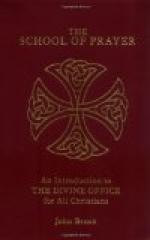The Capitulum, the little Responsory, Christe, Fili Dei vivi ... is then said. In this responsory the versicle Qui sedes ad dexteram Patris is sometimes changed, e.g., in paschal time it is, Qui surrexisti a mortuis.
The manner of reciting this responsory is sometimes not correctly understood, owing, perhaps, to its printed form in some Breviaries. The normal method is to repeat the whole response, then say the versicle, and then the second portion of the response; then the Gloria Patri el Filio et Spiritui Sancto, without the Sicut erat, is said, and the response repeated. The versicle Exsurge and the response Et libera are then said. This is the method of recitation in all the small Hours and at Compline.
After this responsory, if the Office be of double rite or be an Office within an octave, or on the vigil of Epiphany or on Friday or Saturday after Ascension, or on a Sunday on which a double is commemorated, or an octave is celebrated, or on a semi-double feast within an octave, Dominus vobiscum, Et cum spiritu tuo, and the prayer Dominus Deus omnipotens is said. But if the Office be not any of these mentioned just now, the responsory is followed by the Preces.
Preces (Title XXXIV.) In the Breviary there are two sets of preces, the Preces Dominicales for Sunday and the Preces Feriales for ferial Offices. These ferial preces of Prime differ from the ferial preces of Lauds, and are said in Prime when the ferial preces are said in Lauds, That is, on the ferias of Advent, Lent, Passiontide, Ember days and Vigils. The ferial preces of Lauds are found in the Breviary, immediately after the second set of Psalms for ferial Lauds and after the short responsory in the psalm arrangements for the days of the week. (See Lauds, supra, p. 188.)
These prayers were introduced at a very early stage of Christian liturgy. St. Isidore writes that they come from Greek liturgy and the opening words Kyrie eleison seem to indicate remnants of an old litany. Formerly they were read oftener during the liturgical year than we now are called on to repeat them. They are sometimes referred to as the preces flebiles, tearful prayers, because they are said in times of penance, and are formed to excite tears. In choir recitation they are said kneeling. When the preces or the preces feriales are said the sign of the cross is made from the forehead to the breast, at the words Adjutorium nostrum in nomine Domini. Then the Confiteor is said.




